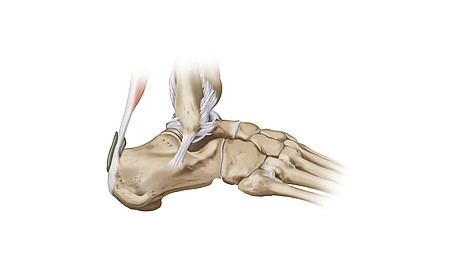Anatomy of the ankle joint
The ankle joint on the foot is made up of two partial joints: the upper ankle joint (articulatio talocruralis) and the lower ankle joint (articulatio talotarsalis). Shin (tibia), fibula and talus form the upper ankle joint, while the lower ankle joint is made up of three bones: the talus, calcaneus and navicular bone.

Right leg from medial (inside)
1: Tibia (shin bone)
2: Fibula (calf bone)
3: Calcaneus (heel bone)
4: Talus (ankle bone)
5: Os naviculare (navicular bone)

Right leg from the side (outside)
6: Syndesmosis (connective tissue between the tibia and fibula)
7: Ligamentum talofibulare anterius (anterior outer ligament)
8: Ligamentum calcaneofibulare (middle outer ligament)
9: Ligamentum talofibulare posterius (posterior outer ligament)
10: Ligamentum deltoideum (inner ligament complex)
The ligaments of the ankle joint
Several ligaments ensure the stability of the ankle joint.
Lateral collateral ligaments (ligaments on the outside of the foot)
The lateral collateral ligaments are made up of three ligaments:
- the calcaneofibular ligament (runs from the outer malleolus to the outside of the calcaneus),
- the anterior talofibular ligament (connects the lateral malleolus to the talus) and
- the posterior talofibular ligament (runs from the lateral malleolus to the back of the talus).
Medial collateral ligaments (ligaments on the inside of the foot)
The ligaments on the inside of the foot provide stability on the inside of the ankle joint, for example the strong medial collateral ligament, also known as the deltoid ligament. It originates on the inner malleolus of the tibia and runs in a fan shape to the navicular bone, calcaneus and talus.
Anatomy and importance of the Achilles tendon
The Achilles tendon is an important structural element for the movement and resilience of the ankle joint. It is the thickest and strongest tendon in humans and is between 15 and 25 centimetres long.
The Achilles tendon is the extension of the calf muscles and attaches to the heel bone. It primarily enables the foot to flex.
The load capacity of the Achilles tendon is enormous
When walking, four times the body weight acts on it, when running almost eight times. The tendon transfers the force of the calf muscles to the heel or foot. This movement is crucial for walking and running. Even when the foot tilts sideways foot, the Achilles tendon is involved.
Injuries and complaints to the ankle joint
The ankle joint is exposed to great stress on a daily basis and is therefore susceptible to various injuries and complaints. These can cause pain, swelling and restricted movement and should be treated by a doctor.
- Stretched and torn ligaments: often due to twisting and spraining
- Fractures: for example of the outer ankle after falls
- Distortion: sprain of the ankle joint, the most common form is, for example, supination trauma (twisting the ankle outwards)
- Chronic instability: Instability of the joint often after repeated twisting due to ligament laxity (ligament weakness) or a functional disorder
- Tendonitis: due to overloading or misalignment
- Achillodynia: painful irritation of the Achilles tendon, common in athletes
- Osteoarthritis: wear and tear of the joint cartilage, often due to overloading or previous injuries
- Joint inflammation (arthritis): caused by rheumatic diseases or infections





